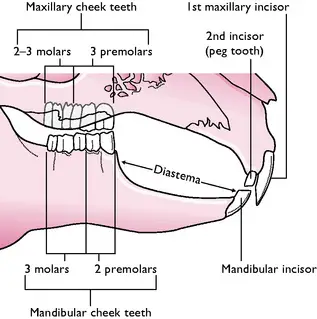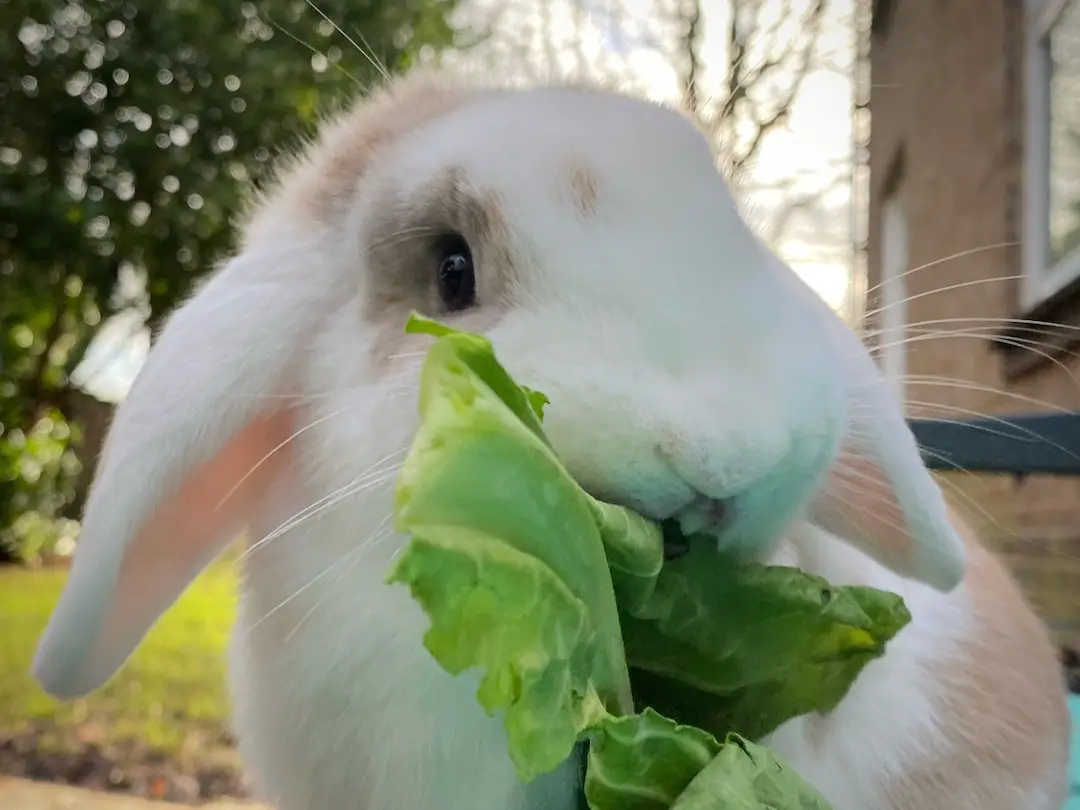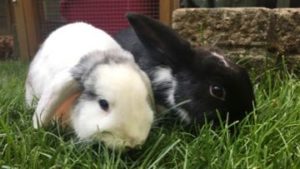Rabbits are great pets. There’s something so cute about the way they hop around, or break out into a zoom around the room or garden. But they’re also extraordinary. Even rabbits’ teeth are amazing. Read on for 14 amazing facts about bunnies’ teeth.
1. Rabbit teeth never stop growing
Your teeth and mine grow when we’re young, and then stop. But rabbits are different. Their teeth just keep on growing through their lives.
In fact, they grow between 3-5 inches (7.5-13cm) every year.
How come you don’t see your rabbit with really long teeth? Rabbit teeth are designed to be worn down by the rough food they eat, like hay and grass. The tough fibres wear away the teeth as they grow, so they are always the same length.
The technical term for this phenomemon where teeth keep growing is elodont.
Rabbit teeth are elodont – they never stop growing
While we’re on technical terms, rabbit teeth are also aradicular – their teeth have open roots – and hypsodont – they have a long crown (the visible part of the tooth) compared to the root (the part of the tooth below the gumline).
In other words, most of the tooth is visible rather than hidden in the gum.
Because rabbit teeth do keep growing, it is vital that they eat food that wears away their teeth – otherwise problems result. See lower down the list for both the problems, and what a healthy diet looks like.
2. Rabbits have 28 teeth

Adult humans have 32 teeth, but rabbits only have 28 teeth. One reason is that we have canine teeth (the sharper, pointy teeth to the side of the front incisor teeth), but bunnies don’t have canine teeth.
Instead, rabbits have three types of teeth:
- Incisors – these are the sharp teeth at the front of the mouth. Rabbits have 6 incisors in total. Bunnies use these for slicing through grass and other vegetation. Rabbits have 4 upper incisors and 2 incisors on the lower part of their jaws. They have two large, central upper incisors, and then two smaller incisors either side. These smaller ones are also called peg teeth.
- Premolars – these are near the back of the mouth, and are used for grinding. Rabbits have 10 premolars in total. Rabbits have 6 premolars on their upper jaw (three each side) and 4 on their lower jaw (two each side)
- Molars – these are also near the back of the mouth, and are used for grinding. Rabbits have 10 molars in total. Rabbits have 6 molars on their upper jaw (three each side) and 6 on their lower jaw (three each side)
The premolars and molars look nearly identical, and together are called cheek teeth.
3. Rabbits have baby teeth, just like us, which they lose as they get older
Baby rabbits have baby teeth, just like children have baby teeth. But while we lose our baby teeth from around the age of 6 years, it’s a lot quicker for bunnies. They lose their baby teeth soon after they are born, and get their adult teeth from around week 5.
Baby rabbits also have fewer teeth than adult rabbits. Baby rabbits have 16 teeth compared with adult rabbits who have 28 teeth. The difference is that baby rabbits do not have any molars. They have 6 incisors and 10 premolars.
The technical term for animals like rabbits and humans who have two sets of teeth is duplicidentata. Now you know!
4. Rabbit teeth grow curved
As the teeth of rabbits grow, they curve. The longer the tooth, the more it will be curved. Incisors curve into the mouth; upper cheek teeth curve outwards (buccally), and lower cheek teeth curve inwards (lingually).
If a tooth becomes too long, it may start to cause problems. The incisors (front teeth) may stick out of the mouth, and catch on things. The cheek teeth (back teeth) won’t be as visible, but if too long can cause a range of serious problems.
The best way to protect rabbit teeth from growing too long is the right diet – see below.
5. Rabbit’s upper incisor teeth have a groove on them
The teeth at the front of rabbits’ mouths are incisors. The two large upper incisor teeth of bunnies have a groove running all the way down them.
6. Rabbits use their incisor teeth for cutting through food
The front teeth of rabbits, called incisors, are sharp. This is so that bunnies can cut through tough food, like twigs or leaves. It also means that they can chop up long grass or hay easily. Once the food has been chopped up by the incisors, it is the turn of the cheek teeth.
7. Rabbits use their cheek teeth for grinding up their food
Once the rabbit’s incisors have chopped and sliced up their food, rabbits use their cheek teeth to grind it up ready for swallowing. Bunnies grind their teeth together in crescent-shaped movements.
Bonus fact – bunnies can only chew on one side of their mouth at a time.
8. Rabbit upper incisor teeth only have enamel on one side – to sharpen them up
Rabbit teeth are made up of four components:
- dentine
- cementum
- pulp
- enamel
Dentine makes up the bulk of teeth in both rabbits and humans. It is a hard tissue, full of calcium apatite (also called hydroxyapatite). The levels of calcium is why it is also sometimes called a calcified tissue. Dentine is harder than bone, but softer than enamel.
Cementum is another calcified, hard tissue that sticks (cements) the tooth to the bone so it doesn’t fall out.
Pulp is the central part of teeth where you find blood vessels and connective tissue.
Enamel is the hardest substance. It contains even more calcium apatite than dentine, and is nearly all (96%) mineral. Enamel forms a thin surface on teeth, to protect them and make them hard enough to cut and chew food.
In rabbits, their upper incisors only develop enamel on one side (the outside, technically called the labial side, as it is the side closest to the lips).
This means that the front of their upper teeth are harder than the back. The softer back part of the teeth, only having dentine rather than the protective enamel, wears away quicker. The result is that the edge of the teeth become sharper. This means they can slice through food even more effectively.
You get a similar effect with the cheek teeth. Here, enamel surrounds the whole tooth, but the middle is made up of softer cementum and dentine. This wears away quicker, leaving a ridge around the tooth of harder enamel.
Again, this means that the cheek teeth have sharp ridges for grinding up tough, fibrous food like hay.
9. There’s a big gap between rabbit incisors and cheek teeth
We generally don’t have big gaps between our teeth. But rabbits are different. For a start, they have no canine teeth. But also, they separate out their front incisors from their cheek teeth. The incisors are at the front of their mouth, and the cheek teeth are set towards the back of the mouth.
The gap between the front incisors and the rear cheek teeth is called the diastema.
10. Rabbits don’t have many nerves in the visible part of their teeth
Rabbits have far fewer nerves in their teeth than we do. If there’s a small gap in our enamel, eating ice cream can turn from pleasure into agony, because the cold reaches nerves in our teeth.
But bunnies are different. They only have a few nerves (which help to tell them how hard they are pressing, for instance). Given how much tough food they have to eat, and that they continually wear away their teeth, you can see that it makes sense.
11. Rabbits chew lots – up to 120 movements of their jaws each minute
Bunnies love to chew. This can include hay, twigs, leaves, and anything you might leave around. Rabbits are designed to chew lots because they need to break down the hard, fibrous food they rely on. So their jaws can chew both up and down and side to side, to cut up and grind down the cellulose and other fibrous food.
They can also chew fast. Rabbits can chew with up to 120 different jaw movements each minute. That would give me jaw-ache.
12. You don’t need to brush your rabbit’s teeth
Some pets need their teeth brushing regularly, even daily. But not so for rabbits.
Rabbits do not need to have their teeth brushed. You should not brush the teeth of your bunnies. Bunnies will be better off just having the correct diet.
Cats’ teeth and dogs’ teeth are similar to ours, and regular brushing of their teeth helps their dental health. However, because rabbits are lagomorphs, their teeth are very different. As they grow continually, there is not the same requirement for daily brushing. Instead, chewing on hay is what will keep rabbit teeth healthy.
13. Good dental health is vital for rabbits
When rabbits have healthy teeth, everything works well. But when there are rabbit dental problems, they can affect bunnies in all sorts of ways (even their eyes).
Vets grade the health of rabbit teeth, with grade 1 being the best. Here’s a quick summary:
Grade 1
Everything normal 🙂
Grade 2
The teeth are starting to get a bit too long, but there may be no symptoms.
Grade 3
Acquired malocclusion – the teeth end up going the wrong way or are the wrong size, and it starts affecting the rabbit visibly. Some of the symptoms may include:
- they find it harder to groom themselves. This in turn can lead to other conditions like flystrike.
- their cheek teeth can develop sharp points, causing cuts inside the mouth. In turn, this can lead to a rabbit losing appetite, producing lots of saliva, and being in pain.
- the nasolacrymal ducts can get blocked or affected. These are ducts connecting the nose and the eyes. The blockages can cause bacterial infections, leading to eye problems such as dacryocystitis (inflammation of the tear ducts).
- rabbits may develop abscesses in their cheeks.
- loose teeth, with tooth infections possible as well.
- Vegetation can get stuck in the teeth.
Grade 4
The tooth stops growing. In cases like this, the rabbit may need to be given soft food.
Grade 5
Rabbits can end up with infections in their bones or abcesses, leading to more severe symptoms.
There are two main causes of acquired malocclusion in pet rabbits. Both relate to their diet. The two causes are:
- not having food that’s rough (abrasive) enough.
- not having food with the right minerals (including the right level of calcium).
Of course, just like humans, sometimes rabbits just bite on something hard and damage a tooth. And sometimes teeth problems are biological in origin. But it’s good to know that, at least for the two main causes, us owners can make sure that our rabbits have the best possible chance for healthy teeth.
If you think that your rabbit might be having any problems with their teeth, check them out with a vet.
14. Rabbits need a healthy diet for healthy teeth
The best, easiest way to make sure that your pet rabbit has healthy teeth is to give them a healthy diet.
For rabbits, a healthy diet means hay and water. The proper hay (preferably timothy hay – find out why here) has nearly all the nutrients that rabbits need. That includes the right amount of calcium for healthy teeth.
But hay also is full of tough, hard to chew fibre. As bunnies cut and grind hay up, it wears away their teeth as fast as they are growing. Eating hay means that the teeth never get too long.
You can feed your bunny other food as well, like an eggcup size portion of rabbit nuggets, a handful of fresh herbs and greens, and a little fruit as a treat.
But if you just feed your rabbit on nuggets, for instance, although they will get all the nutrients they need, their teeth won’t be worn down enough, and could grow too long, creating all sorts of problems.
So, for a healthy bunny, lots of hay and water.
Conclusion
Rabbits are amazing, with bodies designed to make the best possible use of grass and other vegetation. And that means their teeth are amazing, with teeth that constantly grow and sharpen themselves on the food.
Some of the sources used
This resource is aimed at vets, but is full of detailed, technical facts.
This journal article also has some useful facts.
More about rabbits and their amazing bodies…
Find out about how rabbits see the world – it’s not the same as us!
Rabbits have great hearing – see if you can hear sounds as high-pitched as rabbits can
Rabbits are speedy little creatures – find out just how fast
Rabbits like the cold weather much more than we do – find out more
Learn how rabbits digest their food
Find out what minerals and vitamins rabbits need for a healthy life
Are rabbits nocturnal? Find out
Find out how many people own rabbits in the UK, and a host of other facts.


